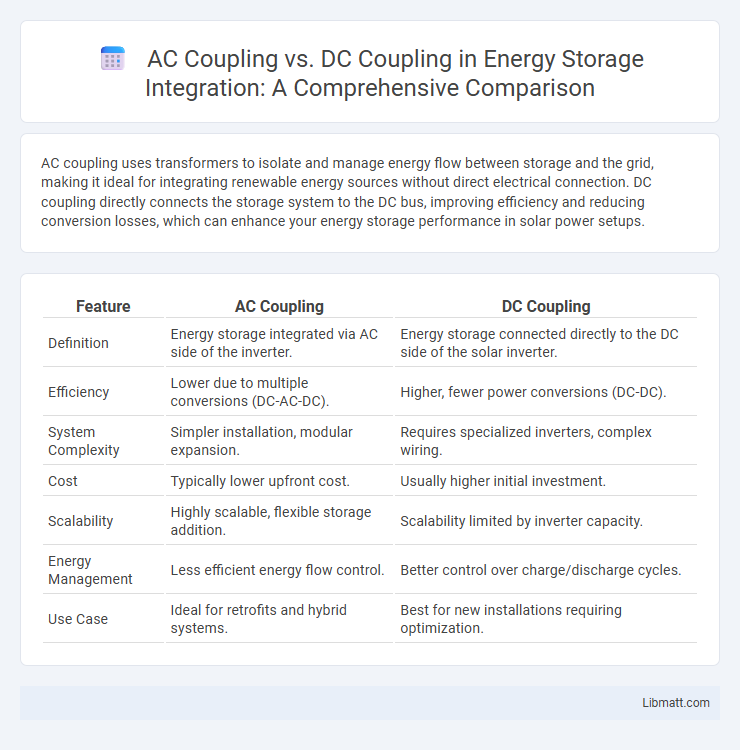AC coupling uses transformers to isolate and manage energy flow between storage and the grid, making it ideal for integrating renewable energy sources without direct electrical connection. DC coupling directly connects the storage system to the DC bus, improving efficiency and reducing conversion losses, which can enhance your energy storage performance in solar power setups.
Table of Comparison
| Feature | AC Coupling | DC Coupling |
|---|---|---|
| Definition | Energy storage integrated via AC side of the inverter. | Energy storage connected directly to the DC side of the solar inverter. |
| Efficiency | Lower due to multiple conversions (DC-AC-DC). | Higher, fewer power conversions (DC-DC). |
| System Complexity | Simpler installation, modular expansion. | Requires specialized inverters, complex wiring. |
| Cost | Typically lower upfront cost. | Usually higher initial investment. |
| Scalability | Highly scalable, flexible storage addition. | Scalability limited by inverter capacity. |
| Energy Management | Less efficient energy flow control. | Better control over charge/discharge cycles. |
| Use Case | Ideal for retrofits and hybrid systems. | Best for new installations requiring optimization. |
Introduction to Energy Storage Integration
Energy storage integration plays a critical role in modern power systems by enhancing grid stability and optimizing renewable energy utilization. AC coupling connects energy storage systems to the grid via an AC bus, allowing flexible configuration with multiple energy sources and simplifying system expansion. In contrast, DC coupling links storage directly to the DC side of photovoltaic arrays, improving overall efficiency by reducing conversion losses and enabling better energy management at the DC level.
Understanding AC Coupling
AC coupling in storage integration refers to the method of connecting energy storage systems to the grid through an inverter, where the battery's DC power is converted to AC before integration. Understanding AC coupling is vital for optimizing renewable energy systems, as it enables flexible, scalable, and efficient energy management by allowing multiple sources to feed into the inverter independently. This approach enhances your system's ability to handle grid fluctuations and improve overall energy reliability.
Understanding DC Coupling
DC coupling in storage integration directly connects the battery system to the DC bus of a solar inverter, enabling efficient energy transfer without additional power conversion stages. This method reduces energy losses compared to AC coupling by eliminating the need for multiple inverters or converters, optimizing overall system efficiency. DC coupling also allows seamless management of energy flows between solar generation and battery storage, enhancing performance in residential and commercial solar-plus-storage installations.
Key Differences Between AC and DC Coupling
AC coupling and DC coupling differ primarily in how they connect solar inverters and battery storage systems to the grid. AC coupling uses separate inverters for solar and battery storage, enabling independent operation and easier system expansion, while DC coupling integrates battery storage directly into the solar inverter's DC bus, providing higher overall system efficiency with lower energy conversion losses. DC coupling typically offers better performance in terms of energy management and cost-effectiveness for new installations, whereas AC coupling is favored for retrofits and existing solar systems.
Advantages of AC Coupling
AC coupling offers greater flexibility in integrating storage systems with existing solar PV installations by allowing independent operation of inverters and storage converters. It simplifies retrofitting and expands compatibility with various inverter brands and models, enhancing scalability. This method also improves system resilience by isolating storage faults from the solar array, ensuring continuous power delivery.
Advantages of DC Coupling
DC coupling in storage integration offers higher overall efficiency by eliminating multiple power conversion stages, reducing energy losses between the solar array and battery storage. It enables superior control and management of energy flow, facilitating better battery charging behavior and extending battery lifespan. Furthermore, DC coupling allows for seamless scalability and integration of additional storage capacity without significant system redesign.
Limitations and Challenges of Each Approach
AC coupling faces limitations such as increased complexity in system design and phase synchronization challenges, which can affect the stability of energy storage integration. DC coupling struggles with voltage level mismatches and requires sophisticated power electronics to manage bidirectional power flow, leading to higher costs and potential reliability issues. Understanding these challenges helps you select the optimal storage integration method based on project-specific technical and economic constraints.
Ideal Applications for AC and DC Coupling
AC coupling is ideal for expanding existing solar systems with battery storage without major inverter upgrades, making it perfect for residential retrofits and smaller commercial installations. DC coupling suits new solar-plus-storage projects where higher efficiency and integrated system management are priorities, often used in larger commercial and utility-scale setups. Your choice depends on system size, integration complexity, and upgrade flexibility requirements.
Cost Considerations and System Efficiency
AC coupling systems typically involve higher upfront costs due to the need for additional inverters and transformers, but they offer more flexibility in integrating storage with existing solar installations. DC coupling often results in greater system efficiency by directly linking the battery to the solar panel's DC output, reducing conversion losses and potentially lowering long-term operational costs. Your choice between AC and DC coupling should balance initial investment against overall energy yield and maintenance expenses.
Choosing the Right Coupling for Your Storage Needs
Selecting the optimal coupling for storage integration depends on system requirements such as energy efficiency, cost, and compatibility with inverters. AC coupling facilitates modular expansion and is ideal for retrofitting existing solar systems, offering flexible storage integration by converting DC power to AC and back. DC coupling enhances overall system efficiency with direct battery charging from DC sources, making it suitable for new installations prioritizing lower energy loss and streamlined control.
AC Coupling vs DC Coupling (Storage Integration) Infographic

 libmatt.com
libmatt.com